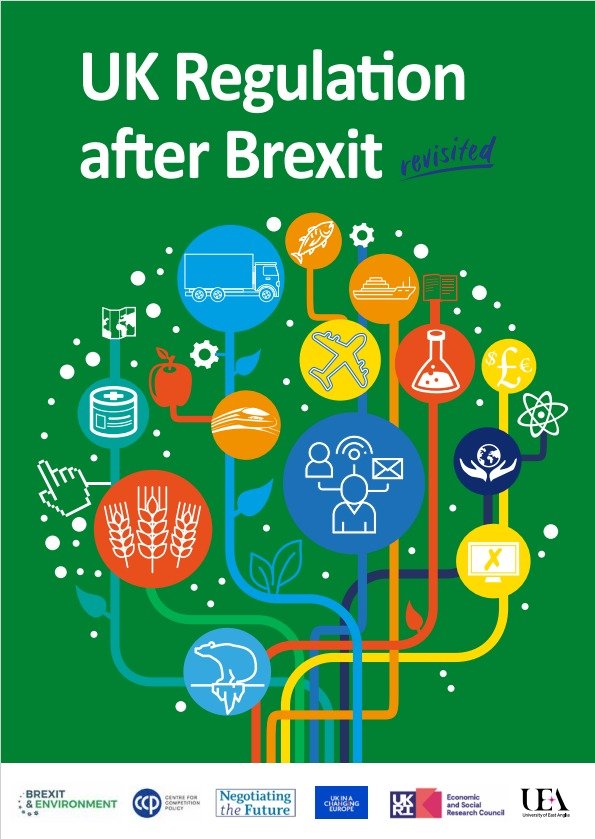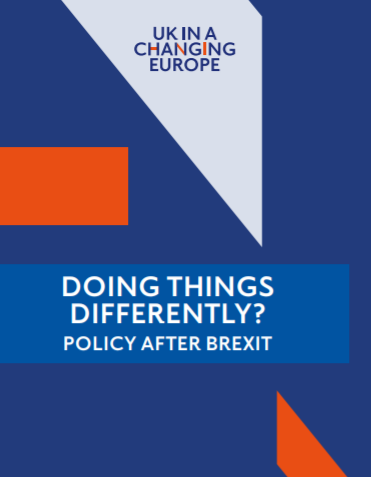‘Negotiating the Future’ and ‘UK in a Changing Europe’ have published a second edition of their interesting report on ‘UK Regulation after Brexit - Revisited’. I had contributed a procurement chapter to the first edition (which has recently been cited in this interesting report for the European Committee of the Regions on the impact on regions and cities of the new trade and economic relations between EU-UK). So I was invited to update the analysis, paying special attention to the (slow) progress of reform of the UK procurement rulebook with the Procurement Bill.
The procurement analysis is below, but I would recommend reading the report in full, as it gives a rather comprehensive picture of how regulation is moving in the UK. For more targeted analysis on regulatory divergence with the EU, this other UK in a Changing Europe ‘Divergence Tracker’ (v5.0) will be of interest.
Public procurement
Public procurement regulation is the set of rules and policies that controls the award of public contracts for works, supplies, and services. Its main goal is to ensure probity and value for money in the spending of public funds – to prevent corruption, collusion, and wastage of taxpayers’ money. It does so by establishing procedural requirements leading to the award of a public contract, and by constraining discretion through requirements of equal treatment, competition, and proportionality. From a trade perspective, procurement law prevents favouritism and protectionism of domestic businesses by facilitating international competition.
In the UK, procurement rules have long been considered an excessive encumbrance on the discretion and flexibility of the public sector, as well as on its ability to deploy ambitious policies with social value to buy British products made by British workers. The EU origin of UK domestic rules, which ‘copied out’ EU Directives before Brexit, has long been blamed for perceived rigidity and constraint in the allocation of public contracts, even though a ‘WTO regime’ would look very similar.
Capitalising on that perception during the Brexit process, public procurement was ear-marked for reform. Boris Johnson promised a ‘bonfire of procurement red tape to give small firms a bigger slice of Government contracts’. The Johnson Government proposed to significantly rewrite and simplify the procurement rulebook, and to adopt an ambitious ‘Buy British’ policy, which would reserve some public contracts to British firms. However, although one of the flagship areas for regulatory reform, not much has changed in practical terms. Reforms are perhaps on the horizon in 2023 or 2024, but the extent to which they will result in material divergence from the pre-Brexit EU regulatory baseline remains to be seen.
Post-Brexit changes so far, plus ça change…
To avoid a regulatory cliff edge and speed up its realignment under international trade law, the UK sought independent membership of the World Trade Organisation Government Procurement Agreement (GPA) from 1 January 2021 on terms that replicate and give continuity to its previously indirect membership as an EU Member State. The UK’s current individual obligations under the GPA are the same as before Brexit. Moreover, to maintain market access, the EU-UK Trade and Cooperation Agreement (TCA) replicates obligations under EU law that go beyond the GPA in substantive and procedural elements (‘GPA+’), with only the exception of some contracts for healthcare services. The Free Trade Agreements (FTAs) with Australia and New Zealand, and the envisioned accession of the UK to the Comprehensive and Progressive Agreement for Trans-Pacific Partnership (CPTPP) foresee further GPA+ market access obligations and increasingly complicated constraints related to trade.
These commitments prevent the adoption of an expansive ‘Buy British’ policy and could in fact restrict it in some industries, although healthcare is explicitly excluded from procurement-related trade negotiations. Despite misleading claims to the contrary in UK governments reports, such as the January 2022 Benefits of Brexit report, which gives the impression that Brexit ‘enabled goods and services contracts below £138,760 (central government), £213,477 (sub-central authorities) and £5.3 million (construction throughout the public sector) to be reserved for UK suppliers’ (art 8), official procurement guidance makes clear that the situation remains unchanged. Contracts above the values quoted above – those covered by the GPA, the TCA, and Free Trade Agreements – remain open to international competition. In other words, the government has not achieved its stated Brexit aspiration of reserving ‘a bigger slice’ of procurement to domestic businesses.
A similar picture emerges in relation to procedural requirements under procurement law. While the UK Government declared that its aim was to ‘rewrite the rulebook’ (as discussed below), the pre-Brexit ‘copy out’ of EU procurement rules remains in effect as retained EU law. Brexit required some marginal technical adjustments, such as a change in the digital platform where contract opportunities are advertised and where high value contract opportunities are published in the Find a Tender portal rather than the EU’s official journal, or the substitution of the European Single Procurement Document (ESPD) with a near-identical Single Procurement Document (SPD). The main practical change following Brexit is the UK being disconnected from the e-Certis database. The lack of direct access to documentary evidence makes it more difficult and costly for businesses and public sector entities to complete pre-award checks, especially in cases of cross-border EU-UK tendering. However, TCA provisions seek to minimise these documentary requirements (Art 280) and could mitigate the practical implications of the UK no longer being part of the e-Certis system.
With Brexit, the Minister for the Cabinet Office assumed the powers and functions relating to compliance with procurement rules. Even if the bar was already quite low before Brexit, since virtually no infringement procedures had been opened against the UK for procurement breaches, this change is likely to result in a weakening of enforcement due to the lack of separation between Cabinet Office and other central government departments. The shortcomings of current oversight mechanisms are reflected in the proposed reforms discussed below, which include a proposal to create a dedicated Procurement Review Unit.
Future change
The government has been promoting the reform of the UK’s procurement rulebook. Its key elements were included in the 2020 Green Paper Transforming Public Procurement. The aim was ‘to speed up and simplify [UK] procurement processes, place value for money at their heart, and unleash opportunities for small businesses, charities and social enterprises to innovate in public service delivery’, through greater procedural flexibility, commercial discretion, data transparency, centralisation of a debarment mechanism, and regulatory space for non-economic considerations. The Green Paper envisaged the creation of a new Procurement Review Unit with oversight powers, as well as measures to facilitate the judicial review of procurement decisions. Despite the rhetoric, the proposals did not mark a significant departure from the current rules. They were ‘EU law+’, at best. However, a deregulatory approach that introduces more discretion and less procedural limitations carries potential for significantly complicating procurement practice by reducing procedural standardisation and increasing tendering costs.
The 2021’s government response to the consultation mostly confirmed the approach in the Green Paper and, on 11 May 2022, the Procurement Bill was introduced in the House of Lords, the day after the Queen’s Speech. The Procurement Bill is hardly an exemplar of legislative drafting and it was soon clear that it would need very significant amending. As of 1 September 2022, the Bill had reached its committee stage in the Lords. Five hundred amendments have been put forward with over three hundred of those originating from the government itself. The amendments affect the ‘transformative’ elements of the Bill, and sometimes there are competing amendments over the same clause that would result in different outcomes. It is difficult to gauge whether the government’s proposals will result in a legislative text that materially deviates from the current rules. It is also unclear to what extent the new Procurement Review Unit will have effective oversight powers, or enforcement powers.
The Procurement Bill, moreover, contains only the bare bones of a future regime. Secondary legislation and volumes of statutory guidance will be adopted and developed once the final legislation is in place. Given the uncertainty, the government has committed to provide at least six months’ notice of the new system. It is therefore unlikely that the new rules will be in place before mid-2023. The roll-out of the new rules will require a major training exercise, but most of the government’s training programme is directed towards the public sector. Business can expect to shoulder significant costs associated with the introduction of the new rules.
These legislative changes will not apply UK-wide. Scotland has decided to keep its own separate (EU-derived) procurement rules in place. Divergence between the rules in Scotland and those that apply in the rest of the UK is governed by the 2022 revised Common Framework for Public Procurement. The Common Framework allows for policy divergence, and has already resulted in different national procurement strategies for England, Wales and Scotland, as well as keeping in place a pre-existing policy for Northern Ireland. It is too early to judge, but different policy approaches may in the medium term fragment the UK internal market for public contracts, especially non-central government procurement.
Conclusion
The process of UK procurement reform may be the ‘perfect Brexit story’. Perceived pre-Brexit problems and dissatisfaction were largely a result of long-lasting underinvestment in public sector capacity and training and constraints that mostly derive from international treaties rather than EU law. As an EU member state, the UK could have decided to transpose EU rules other than copying them, thereby building a more comprehensive set of procurement rules that could address some of the shortcomings in the EU framework. It could have funded a better public sector training programme, implemented open procurement data standards and developed analytical dashboards, or centralised debarment decisions. It decided not to opt for any of these measures but blamed the EU for the issues that arose from that decision.
When Brexit rhetoric had to be translated into legal change, reality proved rather stubborn. International trade commitments were simply rolled over, thereby reducing any prospect of a ‘Buy British’ policy. Moreover, the ongoing reform of procurement law is likely to end up introducing more complexity, while only deviating marginally from EU standards in practice. Despite all the effort expended and resource invested, a Brexit dividend in public procurement remains elusive.










